How Box Conquered the Enterprise and Became a $1.7 Billion Company in a Decade
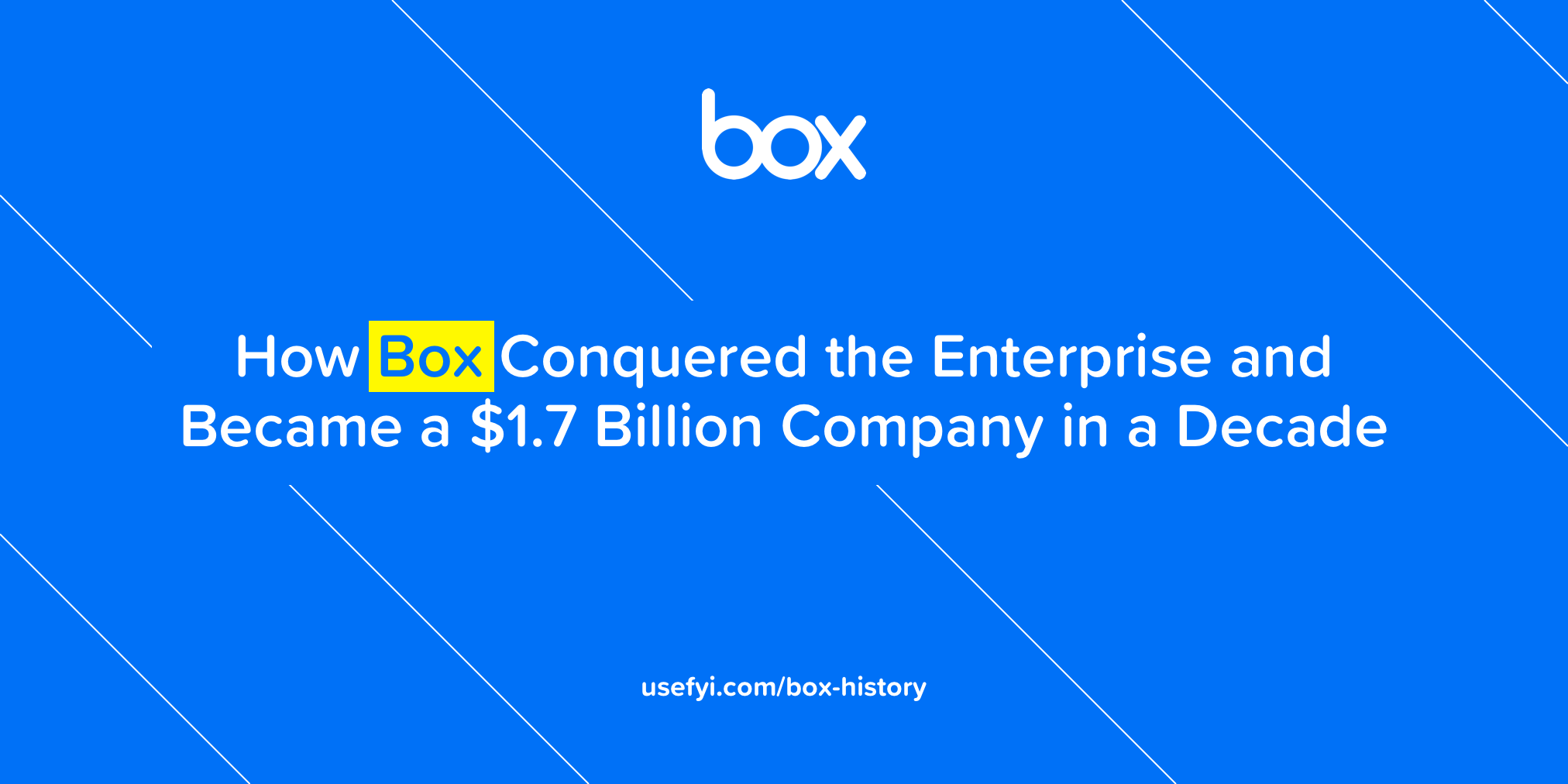
The myth of the college student who drops out to create the world’s next technological innovation in their garage is one of Silicon Valley’s most well-worn tropes. Yet every few years, a visionary young entrepreneur emerges who genuinely does change the world with their startup.
Aaron Levie, co-founder and CEO of Box, is one such entrepreneur.
Since founding Box in 2005 during his time as a student at the University of Southern California, Levie and his co-founders have grown the company to become one of the premier enterprise IT firms in tech. What’s really remarkable about Box is that it began as a purely consumer-focused cloud-based file-sharing product before pivoting to become one of the most successful enterprise cloud services in the world.
Let’s take a closer look at:
- Why Box was such a radical idea in 2005—and the very real technical challenges the company had to overcome
- How design, UX, and consumer SaaS products have shaped Box’s growth as an enterprise-focused company
- Why hiring a single consultant was the smartest move Box ever made
Today, Box is an enterprise heavyweight used by some of the largest corporations in the world, but Box didn’t have its sights set on the enterprise initially. Instead, Box’s journey began like so many other startups—as a great idea for the consumer market.
2005-2009: From USC to the C-Suite, from Consumer to Enterprise
In 2003, Aaron Levie enrolled in an undergraduate program at the University of Southern California to study business. In terms of academic goals, this was about as far ahead as Levie had thought.
Despite being just 19 years old, Levie was a serial entrepreneur by nature. He had spent much of his life dreaming up business ideas that ranged from the improbable to the impossible. There was Zizap, a rudimentary search engine that Levie self-deprecatingly described as “the world’s fastest search engine if you have never been to Google.” There was Fastest.com, a real estate site intended to help buyers and sellers alike close deals on property as quickly as possible. There was socalendar.com, a short-lived events listings website focusing on parties and exclusive happenings in and around Southern California.
Although Levie was the creative force behind his myriad business ideas, he was not alone. Levie’s closest friends—Sam Ghods, Jeff Queisser, and Dylan Smith—had grown up with Levie on Mercer Island in the Puget Sound region near Seattle. The four friends had been near-inseparable in high school, and Levie’s three confidants had embarked on many of his zany business ventures with him over the years. As it turned out, Levie’s keen business acumen would make all four young men multimillionaires in just a few short years.
In 2004, with his major still undecided, Levie accepted an internship at Paramount Pictures in Los Angeles. It was during his time at Paramount that Levie saw firsthand how difficult it was for the studio to share large files, even internally. Production staff resorted to a range of methods to share information, from emailing zipped directories to themselves to relying on USB thumb drives. Although these workarounds got the job done, Levie thought there had to be a better way.
It was at this point that the idea for Box was born.
“To share files, people had to email files to themselves, use thumb drives, use an FTP, and it was way too complicated and inefficient. So we had an idea and launched it in early 2005: People would pay us $2.99 a month, we’d give them 1GB of storage, and they could upload their files to Box, and access them anywhere.” — Aaron Levie
Levie and his three co-founders had a great idea. What they didn’t have, however, was any real business experience or even a firm grasp of basic business concepts. Regardless, the four friends were undeterred. As the “idea guy” and the most knowledgeable of the four, Levie was the clear choice for CEO. Dylan Smith’s sense for figures made him the obvious pick for CFO. Although his technical chops were lacking, Ghods had the most programming experience, making him Box’s CTO. Finally, Queisser’s practical experience of installing cable modems secured his position as Box’s head of IT.
When Box launched officially in 2005, Levie and Smith used $15,000 in online poker winnings that Smith had been saving to rent server space. Levie figured they could charge $2.99 per 1GB of storage, which only cost them $1. This wasn’t sustainable in the long-term but would allow the new company to secure its first few thousand customers and bring in some much-needed revenue. Armed with prospectuses about their new online storage company, Levie and Smith approached dozens of venture capitalists across the Pacific Northwest in pursuit of funding.
Every single one of them turned Levie and Smith down.
“We were 19 or 20 at the time, and Seattle investors just didn’t believe in the idea or the team. A lot of them were burned by the dot-com bubble, but we were also really on the young side. Dylan looked like he was 14 years old. We didn’t look like a credible founding team.” — Aaron Levie
Box’s early difficulties in securing seed funding weren’t indicative of Box’s viability as a product. Box was a great idea. The problem was there were plenty of other companies that were chasing that great idea. By early 2006, at least a dozen cloud storage companies were vying for dominance, including Allmydata.com, Mozy, Strongspace, and Xdrive. A highly competitive emerging market and Levie’s lack of leadership and real-world business experience made Box too risky a proposition for most VCs. For most companies, this would have been the end. The graveyard of failed startups is littered with great ideas. However, Box wasn’t dead just yet. In an effort to secure some badly needed media attention, Levie had emailed dot-com billionaire Mark Cuban a pitch for a story with a view to securing a mention on Cuban’s blog.
Instead, Cuban wrote back to Levie saying he wanted to invest in the young company. Six weeks after that fateful email, Levie and Smith sold Cuban a 30% stake in Box for $350,000.
Aside from the nature of their business, what the cloud storage companies of the mid-2000s shared was their primary focus on the consumer. There were two factors that pushed Box toward the consumer market. The first was rapid advancements in internet delivery technologies and accelerated adoption of broadband internet in American homes. Between March 2005 and March 2006, home adoption of broadband in the U.S. increased by more than 40%, more than double the year-over-year adoption rate from 2004 to 2005. More people going online meant more content—more songs, more movies, and more documents—all of which needed somewhere to live besides people’s hard drives. The second was the rapidly falling cost of online storage. Although the capacity of hard disk drives had been increasing for several years, costs of online storage had plummeted by 2006. Combined, these two factors made targeting the consumer market practically a foregone conclusion.
The earliest version of Box.net, the first of many iterations of the Box product, was pretty rudimentary. Initially, functionality was largely restricted to file uploading and downloading with some basic search functions. The product was entirely web-based, which eliminated the need for users to download and install a desktop program. This seemingly little detail was significant, as it would later allow users behind corporate firewalls to access and use Box without asking an IT administrator for permission. This would work brilliantly in concert with Box’s freemium model.
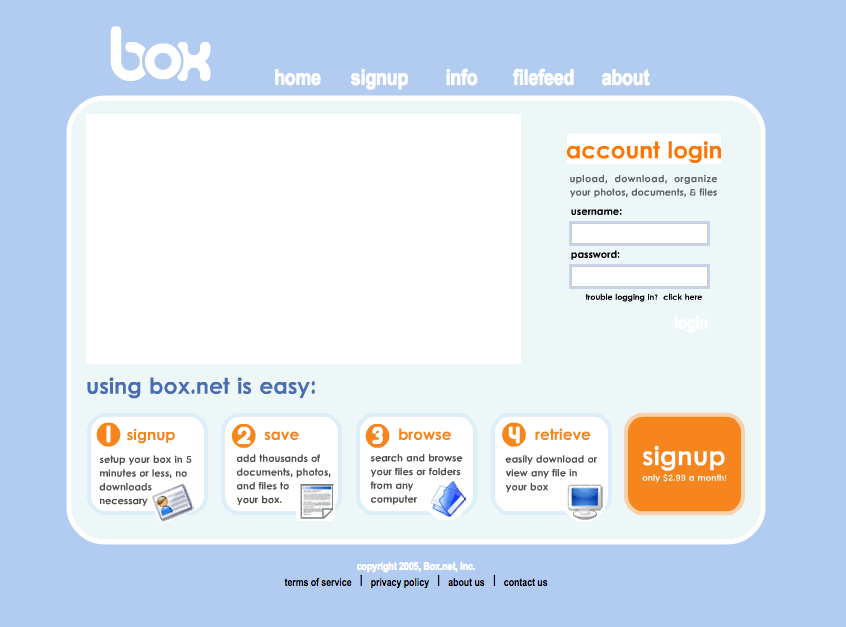
Much of the friction around data transfer and storage that Levie and his co-founders experienced had been at the intersection of digital media and consumer hardware, such as accessing and sharing music files between devices. Levie correctly foresaw consumer demand for cloud-based storage years before it became mainstream. The problem was that the consumer market for cloud-based storage in the mid-2000s was tiny. Despite the diminutive size of the consumer market for their product, Box was remarkably popular.
Growth had been steady, but by early 2007, Levie began to wonder whether the consumer market was big enough to sustain the kind of growth he envisioned. To complicate matters, some of Silicon Valley’s biggest players, including Apple, Facebook, and Google, were branching out into cloud-based storage. Specialized services, such as image hosting site Flickr, were gaining in popularity. However, that wasn’t the only potential threat facing Levie and his young company. On June 1, 2007, MIT students Arash Ferdowsi and Drew Houston launched their online storage startup Dropbox out of the Y Combinator accelerator. Dubbed a “Google Drive killer” by the tech press, Dropbox put Box.net under even more pressure in the burgeoning consumer cloud storage market.
However, what most people failed to understand—and continue to misunderstand to this day—is that Dropbox was never launched as a competitor to Box. The use cases were completely different. Box.net and Dropbox may have shared some similar underlying technologies (and an uncomfortably similar name), but the focus of Dropbox was cloud-based file management for the consumer market. Box was focused on file sharing. By the time Dropbox launched in 2007, Box.net had already largely abandoned the consumer market in favor of the enterprise. There were other key differences between the two products, such as the necessity of installing a dedicated Dropbox directory on a user’s local machine versus Box.net’s entirely cloud-based interface. Additionally, the two companies’ target markets and business models couldn’t have been more different.
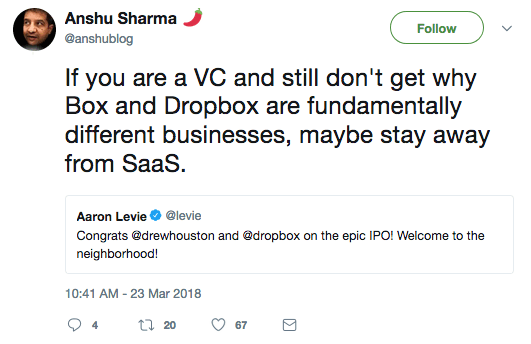
Although Levie had been reluctant to turn his attention to the enterprise market, Box’s pivot away from the consumer market was essential to the growing company’s survival.
The problem was that he knew next to nothing about the enterprise market.
To learn more about the enterprise and the continued viability of the consumer market, Box hired a consultant. This is arguably the smartest move Box ever made as a company. Many entrepreneurs resist investor pressure to “hire an adult” to handle specific business tasks—often to their own detriment. Not so with Box. Levie knew his idea was solid. More importantly, he knew what he didn’t know and wasn’t afraid to hire someone who knew what they were doing. The consultant’s job wasn’t solely to determine the prospective size of the cloud storage industry—it was to determine whether cloud-based storage had a future at all.
“We realized that we could actually use our consumer DNA and the consumer sort of ethos of the company—we were very small at the time, about 15 people—but we could use that ethos to attack the enterprise market and actually be very disruptive to traditional enterprise storage technology, document management, software collaboration tools, and we didn’t have to change the fundamentals of our product or our consumer orientation.” — Aaron Levie
As it turns out, Levie’s instincts were right on the money. The consultant Box hired conducted in-depth market research for the growing cloud storage industry and came to the same conclusions Levie had: that demand for cloud-based storage would likely increase over the next decade. However, the consultant also warned Levie that heightened competition from the Valley’s biggest tech companies would be difficult, if not impossible, for a scrappy startup like Box to compete with. Although this wasn’t the report Levie and his co-founders were hoping for, it was a crucial step in testing and validating a potential market before committing to considerable financial or strategic decisions.
Unlike the increasingly crowded consumer market, the enterprise had far fewer options for cloud storage. The biggest player in the market when Box launched in 2005 was Microsoft’s SharePoint, which was released four years prior in 2001. SharePoint was a quintessentially Microsoft product. Its primary competitive advantage was its integrations with Microsoft Office, which made it an attractive platform for corporate environments. However, the qualities that made SharePoint a uniquely Microsoft product were the same qualities that provided Box with a unique opportunity. SharePoint’s functionality and integrations were solid, but the interface was characteristically utilitarian. Useful options were concealed behind unintuitive menus. SharePoint’s search function was terrible. Sharing files within an organization was (relatively) easy. Sharing files with people outside of a company? Not so much.

SharePoint may have been the “dominant” enterprise file-sharing system in the early 2000s, but it was vulnerable. Not only was it the only real file-sharing and storage product available for large corporate environments, but it was also unwieldy, unintuitive, and unpopular.
This was the opportunity Levie had been waiting for.
Levie knew SharePoint was Box’s biggest competitor, so he did what any inventive, irreverent entrepreneur would do—he took out a billboard advertisement on a stretch of highway on Route 101 between San Francisco and Silicon Valley. The ad promised SharePoint users that Box would pay for three months of SharePoint access if they didn’t prefer Box. In February 2009, Box went one step further in its media assault on Microsoft by erecting another billboard, this one highlighting the many aspects of SharePoint that were most unpopular among its user base.
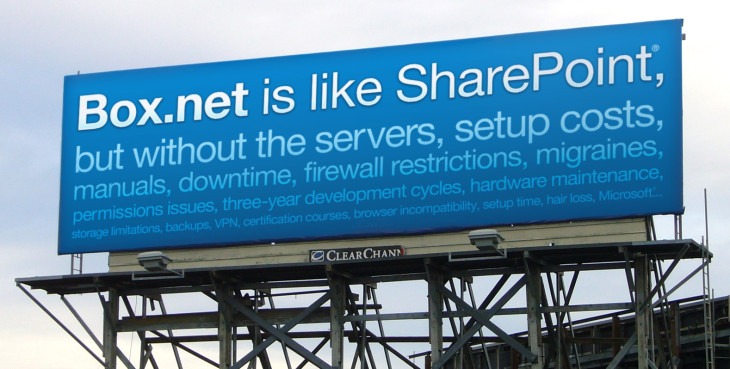
This campaign wasn’t just a clever way to attract users at Microsoft’s expense. It represented what would ultimately become Box’s single biggest competitive advantage: its simple, consumer-focused interface. For years, enterprise software had been defined by its utilitarian nature. Enterprise apps mostly looked—and felt—the same. Color palettes were almost exclusively blue and gray, common colors among enterprise software applications due to their connotations of trustworthiness and reliability. Users were forced to navigate through mazes of hidden submenus to access advanced functions. In short, enterprise software worked well but using it was a nightmare.
Box would change all that.
Even in 2009, Levie was excited about what he described as “the consumerization of the enterprise.” Until that point, not only had enterprise software development focused almost exclusively on function over form, it had done so at a glacial pace. Enterprise apps were ugly because the average enterprise development cycle lasted years, not months. Levie was intrigued with the idea of applying consumer-focused design sensibilities to enterprise software. More importantly, Levie saw an opportunity for Box to distinguish itself amid a sea of cornflower-blue enterprise applications by leveraging consumer-focused design and establish itself as a leader in enterprise software development by rethinking how enterprise apps looked, felt, and worked.
“Why, in the workplace, are you using worse technology than in our personal lives when we actually spend way more money on technology in the workplace? The buyer was an IT buyer, not the end user. The end user really had no power to affect the kinds of decisions that were being made in the software development process. That’s all changed in the past couple of years.” — Aaron Levie
While the enterprise market represented a unique chance for Box to pivot away from the increasingly competitive consumer market, essentially shifting the focus of the entire company was no small undertaking. Until that point, Box had used a freemium business model. This worked fine for the consumer market, but it was completely unsuitable for the enterprise. This meant Box would not only have to radically redesign its product from the ground up but also restructure its entire business model.
Despite the challenges—and considerable risks—that came with the prospect of a radical pivot, Box took the plunge. In 2007, Box became an exclusively enterprise-focused company. Although the commercial realities of the consumer market forced Box’s hand to an extent, the company’s strong B2C focus would actually become one of Box’s greatest competitive advantages.
2009-2015: Becoming ‘Dropbox for the Enterprise,’ Going Public
Despite the company’s growing pains, Box continued to grow throughout the late 2000s. Between 2008 and 2009, revenue increased by more than 500%, with year-over-year growth of 300% in Q1 of 2009 alone driven by a series of partnerships with brands including: Nokia Siemens, the Oprah Winfrey Network, and Volvo. By 2010, Box had more than 4M users across tens of thousands of companies.
It was during this period that Box began to add functionality more commonly found in consumer-facing apps. Most notably, this included social functionality. Users could customize unique individual profiles, which included contact information, such as IM handles and lists of common collaborators, as well as bookmark directories. Users could also add notes to specific files, allowing teams to discuss entire projects without leaving Box. These innovations weren’t just designed to make Box feel more like a consumer-focused app. They were developed to make Box a much stickier software product. Levie and his team knew that file sharing and data storage were only part of the problem their users were trying to solve—Levie wanted Box to make working across the entire enterprise easier, faster, and more intuitive. What Box understood was that, in a world of instantly delivered cloud software, it wasn’t just consumer apps that would need to be easy to use and functional.
“I’m a firm believer that even applications developed primarily for the enterprise, like Box, need to be pushing the leading edge for user experience and design. They have to be ‘consumer-grade’ in terms of their usability, simplicity, speed, and performance. This definitely raises the bar for enterprise software design and engineering, but there’s no doubt that the higher standards are a big win for users and a massive opportunity for Box.” — Sam Schillace, VP Engineering, Box
In 2009, Box unveiled a radically redesigned, simplified UI that made navigating virtual directories much easier. The app still featured the predominantly blue color palette favored by many enterprise apps, but everything else looked more like a consumer-focused application and was significantly more intuitive. Core functionality such as file and folder uploads was handled by Web 2.0-style buttons and drop-down menus. Managing teams and individual collaborators was effortless thanks to Box’s straightforward management tools. Metadata management in Box felt more like managing tags in WordPress than working with complex organizational taxonomies. Users could see at-a-glance which documents and files had been edited and by whom and when.
It was an entirely new way of using enterprise software.
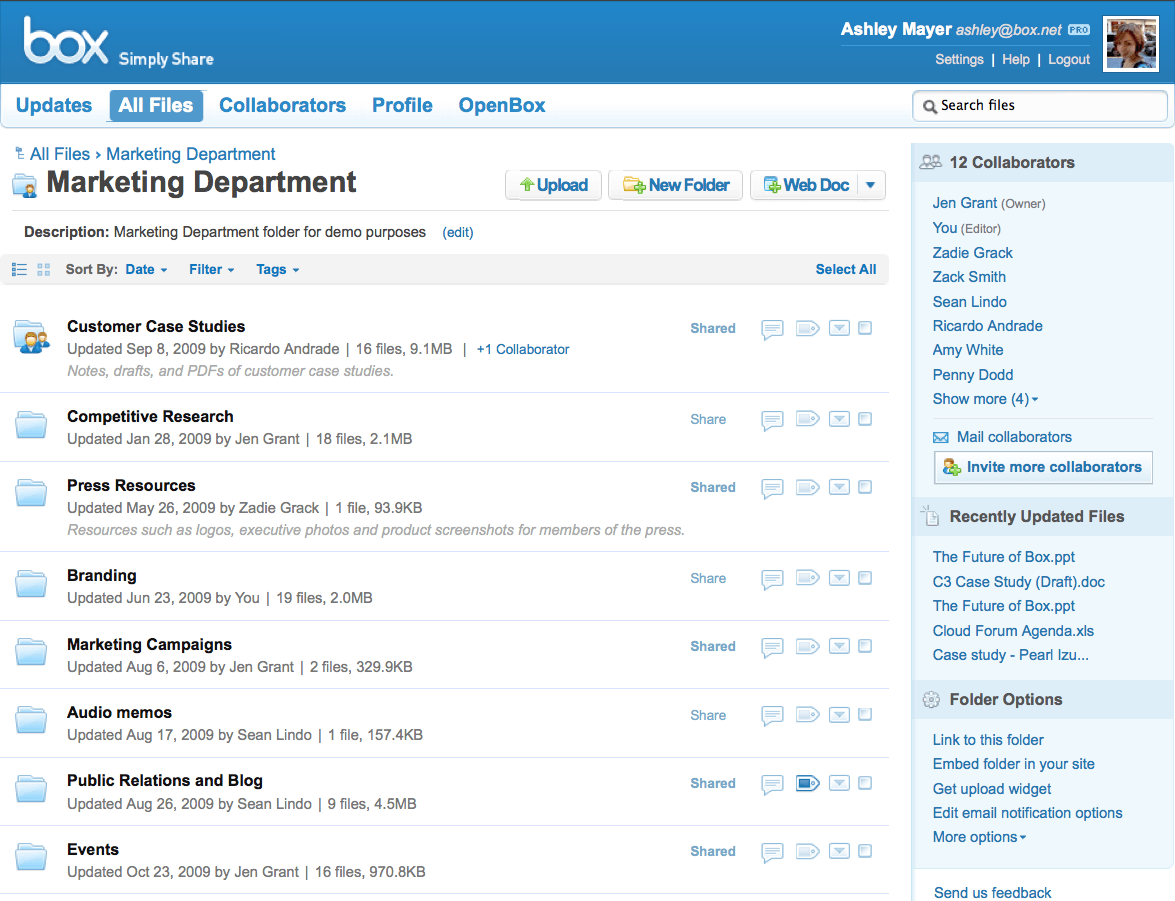
Box’s strategy to push enterprise software toward consumer-focused design was twofold. One, it made enterprise software significantly easier to use, which made Box a much stickier application. Two, it helped users be more productive. The less time users had to spend learning how to use software, the more time they could spend solving actual problems. This, in theory, would drive growth. Not only was Box making a tool that was easy and great to use, but the company was making it work with all the other tools people used in the office via integrations.
However, although Box’s new social functionality and redesigned interface were popular with users, one of the company’s biggest challenges was diversifying its product’s functionality to keep pace with that growth. That’s what made Box’s acquisition of Increo Solutions, the first of many such acquisitions Box would make in the coming years, so strategically significant. By acquiring Increo, Box immediately gained access to Increo’s innovative document collaboration tools. This was crucial. It wasn’t enough for Box to offer cloud-based storage or integrations with Salesforce and Office. It had to offer additional value as competing tools vied for dominance. As Levie noted in an interview in 2013, “When you think about a cloud and mobile world, you have to get much closer to the actual content creation.” This was exactly what Box’s acquisition of Increo Solutions did.
Box continued to develop its product with end users in mind. Every major feature release was designed to make Box easier, faster, and more intuitive to use. This was demonstrated with the release of Box Notes in 2013. Intended to combat both Microsoft’s legacy Office products and the ever-present threat posed by Google Docs, Notes was introduced as a way for users to make quick and easy annotations to files and directories. However, although Box was shoring up its product by introducing Notes, it did so in an interesting way. Notes could have been developed to be much more fully featured, but Box deliberately kept Notes as simple and lightweight as it could. Levie described Notes as being closer to Evernote than Microsoft Word because that’s what users wanted. Levie didn’t care about competing with Word or Google Docs—he wanted to get Box users as close to the moment of creation as they could be, at the right time, in the right place. Everything else was secondary.
The consumerization of enterprise IT driven by Box and other forward-thinking companies wasn’t merely an attempt to cultivate a unique value proposition or drive adoption. It reflected much broader shifts in computing in general. The advent of Web 2.0 apps created a new design paradigm that placed emphasis on ease of use and accessibility across multiple devices over complex file management tools. Smartphones fundamentally changed the way we think of computing. For an enterprise software company like Box to be at the forefront of trends in usability was impressive.
“The file system is going away as a concern for normal computer users. We see a future five years from now where, unless you’re a developer, you’re not touching a file system. You’re touching your applications, and your applications manage your data.” — Andrew Lee, founder, Firebase
Over the next two years, Box continued to grow. However, unlike its earlier years, much of the growth during this period was driven by increasingly large investments. Between October 2009 and October 2011, Box raised more than $150M in venture capital over a series of funding rounds led by investors including DFJ, Meritech Capital, and Scale Venture Partners. Much of this funding was used to expand the company aggressively. While staffing was among Box’s most significant costs, a substantial amount of the company’s capital was invested back into product development. This culminated in the release of Box OneCloud in March 2012.
OneCloud was an excellent example of how consumer-focused design informed Box’s broader strategy. The company had built a platform for developers in 2011 known as the Box Innovation Network, which functioned similarly to an app marketplace. OneCloud was an extension of this idea, only it was intended exclusively for mobile devices. This would later become a predictable cycle in Box’s development. New features were added to the product to meet emerging needs, and those features were presented to users in ways that directly mirrored those of consumer apps and sites.
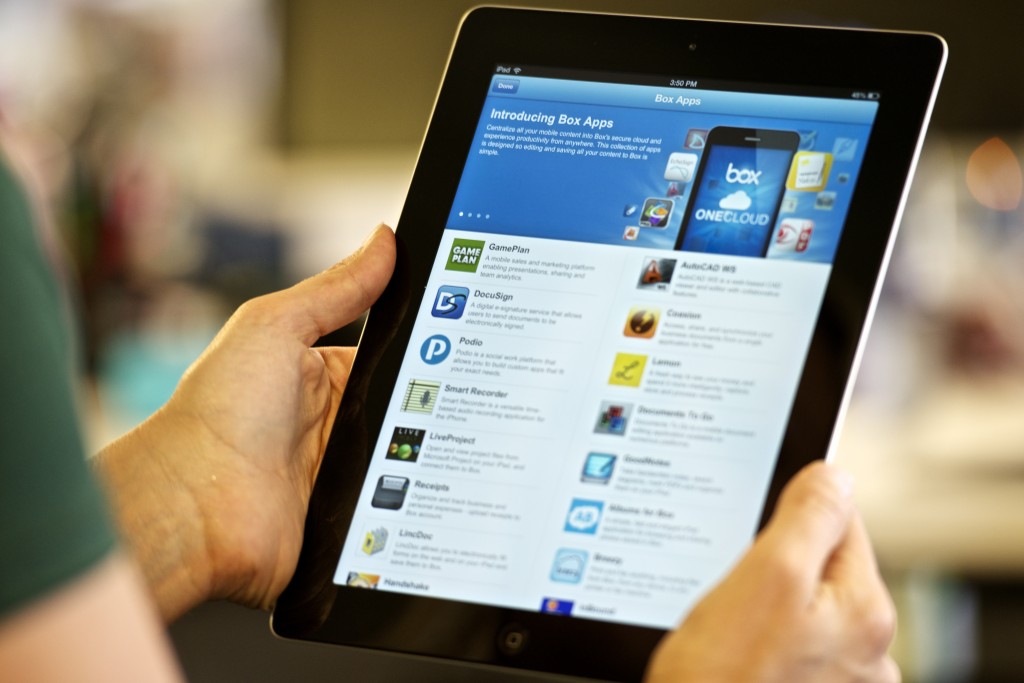
Box’s commitment to user-centric design wasn’t just attracting new users—it was converting Box’s free users, too. Despite being focused solely on the enterprise, Box had retained its freemium model. The free version of Box offered users basic functionality completely free of charge. If users wanted additional features, such as password protection for certain directories, they could pay $15 per month. By 2011, Box had more than 5M users across 60,000 companies. What’s more important, however, is how well Box converted its free users to paid subscribers. Consumer apps like Evernote convert free users to paid plans at a rate of approximately 3%. Box was converting free users to paid plans at a rate closer to 8%, including major corporate customers such as Bank of New York and ambient advertising powerhouse Clear Channel. As a result, Box achieved revenues of more than $11M in 2011.
Additionally, Box’s use of the freemium model made it easier to sell as a product. Since the basic version of Box is completely free, most users who were ready to upgrade from a free account to a paid plan had already been using Box for some time. This meant that, by the time a sales representative picked up the phone to call a prospective lead, there was no need for the sales professional to try and coerce the prospect into a product demonstration or explain the product’s core features or value proposition. Because most of Box’s sales calls came from companies that had already been using the product, Box’s sales teams were typically able to close 60% of those deals within two weeks—an impressive figure, especially considering the often months-long sales cycles typically associated with the enterprise market.
By 2015, Box had developed a reputation for bucking trends and defying the predictions of so-called experts. Despite the company’s proven track record of growth, many analysts still doubted Box’s prospects. Some analysts criticized the company’s extensive marketing efforts as proof of poor leadership and a floundering product. Others claimed Box would never reach profitability. However, Box once again defied expectations on January 23, 2015, when Box began trading publicly on the New York Stock Exchange. Box’s IPO was one of the largest of 2015 at that time, and gave Levie’s company a valuation of approximately $1.6B. Box wasn’t yet profitable, but when the company’s shares closed 66% higher than their IPO price, analysts were floored by the demand.
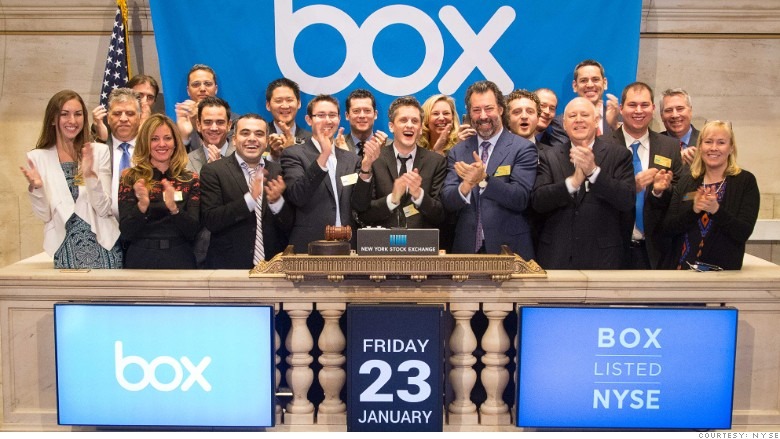
Box had consistently defied conventional wisdom in the enterprise space by embracing the spirit of innovation and responding to industry changes in a timely manner, a holdover from its days as a consumer-focused company and a stark contrast to the typically glacial pace of innovation that the enterprise is known for. Box had worked hard to differentiate itself from its emerging competitors—and it would continue to do so by embracing machine learning and artificial intelligence.
2016-Present: Welcome to the Machine: Embracing AI in the Cloud
By 2016, more than 54,000 companies worldwide were using Box. The company had approximately 44M users and was generating roughly $300M in annual revenue. Box had successfully pioneered the consumerization of the enterprise. Having moved everyone’s files to the cloud, the next step for the company is to make accessing those files easier, faster, and smarter by incorporating artificial intelligence and machine learning.
As a product, Box had become remarkably diverse without sacrificing its core functionality. In February 2016, Box added a document-scanning feature to its iOS app and introduced Box KeySafe, which gave users more control over how their encryption keys were managed. This was an extension of the functionality that Box introduced as part of its Enterprise Key Management tools, which were aimed at companies operating in highly regulated industries or verticals with exacting compliance requirements.
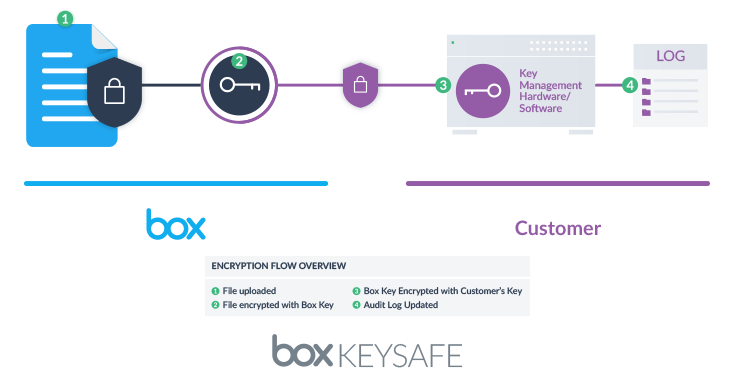
Box’s encryption tools are an excellent example of how Box simplified and streamlined its core functionality without compromising on quality. KeySafe is crucial for many of Box’s clients, but the tool itself was designed so that virtually anybody can use it without sacrificing security or data integrity. Reviewing audit logs takes skill and expertise but accessing the tools to do so is simple, which allows for greater productivity and fewer personnel bottlenecks in larger organizations.
Two months after the launch of KeySafe, Box introduced Box Zones, which allowed Box customers to control how and where their data is stored at the regional level. This was a smart move on Box’s part in light of the regulatory difficulties posed by region-specific data legislation, such as the European Union’s General Data Protection Regulation. Since many of Box’s customers are multinational corporations, it made sense to allow these companies to exert greater control over their data sovereignty. However, Box’s next real innovation would come in 2017, when Box partnered with Microsoft on an ambitious plan to integrate AI and machine learning capabilities into Box and build upon Microsoft’s Azure server technology.
“Microsoft shares our vision to transform how people and organizations work, and Box and Azure together can unlock incredible opportunities for innovation.” — Aaron Levie
Although the partnership hinged on Microsoft’s Azure ecosystem, Box Zones was central to the collaboration. Data would be managed at the regional level to meet the unique needs of teams around the world, while machine learning would be applied to tasks such as metadata creation, an area in which human error can have significant implications. However, while AI and machine learning were integral to Box’s vision as a company, this innovation was another extension of Box’s philosophy as an organization. As Box’s Chief Strategy Officer and SVP of Platform, Jeetu Patel, observed, “You start with the customer and work backwards.” This was what Box had been doing for years. The company anticipated what its clients needed, then delivered it as simply and intuitively as possible.
AI and machine learning may be the trendiest technologies du jour in today’s tech sector, but they’re far more than that to Box—they’re a way for Box to unite the dozens of disparate CMS and systems in place across the cloud in one secure, decentralized platform that can be adapted and modified to suit a range of workflows.
Box has done an excellent job of not only carving out its own niche in an increasingly competitive space but also by applying design and UX principles of consumer-focused SaaS products to redefine how enterprise software looks, feels, and works. With its keen focus on usability, ease, and simplicity, Box has become a leading force in the consumerization of the enterprise and has shaped how other enterprise software companies approach their products.
Where Box Could Go from Here
File sharing and cloud storage may not be the most exciting use cases for new technology, but the ways in which Box could grow over the coming years are very exciting. Where could Box go from here?
1. AI everywhere
Box’s focus on artificial intelligence and machine learning will be a driving force behind much of Box’s R&D and product development in the foreseeable future. These technologies are likely to be applied to virtually all aspects of Box’s business, from more intelligent and responsive indexing and search functionality to personalized recommendations and virtual assistants. Greater automation of routine tasks will also feature prominently in future versions of Box, which ties back nicely to Box’s mission to simplify and streamline cloud-based file sharing.
2. More corporate partnerships
Box has already made inroads with some of the world’s largest enterprise software and computing firms including Fujitsu, IBM, and Microsoft. We can expect to see more partnerships like this in the future and may see Box explore bespoke solutions for the largest enterprise companies developed as part of these partnerships. These partnerships are likely to be of increasing importance, especially given the infrastructural and developmental challenges inherent to emerging technologies such as AI and machine learning.
3. Greater emphasis on specialized compliance tools
Box already offers a range of data sovereignty products, such as Box Zones and Box Governance. As countries around the world continue to develop and introduce broad data regulations, such as the European Union’s GDPR, Box may expand its product range to offer a greater variety of specialized data protection and compliance tools for larger companies operating across multiple compliance areas.
3 Lessons We Can Learn from Box
Box’s journey has certainly been unconventional. Despite its focus as an enterprise company, Box has plenty to teach entrepreneurs in all verticals. What can we learn from Box and its journey?
1. Thoroughly research and validate demand in your industry.
Before it made its pivot from B2C to B2B, Box carefully evaluated its position and the potential of the enterprise market. One of the smartest things the company did was to hire a knowledgeable consultant to help the company identify opportunities in the enterprise space. Researching and validating the potential demand in a new market is crucial to lasting success.
Think about your industry—and your company’s position within it—and answer the following questions:
- Are you ignoring a stronger long-term market in favor of short-term returns? If so, why? Are you succumbing to investor pressure, or worse, trying to give investors—not users—what they want? Could pivoting into a different market provide your company with a clearer path to sustainable growth?
- Think about how you would propose a pivot like the one Box made. How would you present this proposal to investors or your board? Are any of your hypothetical talking points indicative of broader trends that are worth exploring? Think about the kind of material you’d use in a pitch deck for making a radical pivot. How much of this data are you using right now?
- It’s not hyperbolic to say that Box’s decision to hire a consultant arguably saved the company from almost-certain doom in the consumer market. If you could hire a single individual to consult on your company’s trajectory, who would it be and why? How can you gain the kind of insight into your current market that Box gained by hiring a consultant to evaluate the consumer data storage market?
2. Find—and focus on—the right message.
From the outset, Box identified the consumerization of IT and software products as a central pillar of the company’s messaging. What made Box really successful in this regard was remaining laser-focused on that messaging and owning it from start to finish. This helped Box develop a truly unique value proposition and established the company as a trendsetter in the enterprise SaaS space.
Consider the messaging surrounding your product:
- Every industry has its “good guys” and “bad guys” when it comes to perception and public image. Every Google Fiber has its Comcast, and every Box has its SharePoint. Which side would your company fall on if you asked your customers?
- Box didn’t just want to disrupt the enterprise market by applying consumer-focused design principles to enterprise software—it wanted to fundamentally change how we think about and use enterprise software. Are you trying to win hearts and minds, or are you focusing solely on the usual metrics?
- Lots of companies talk a good game about “thought leadership,” but far fewer entrepreneurs genuinely distinguish themselves in their fields. Aaron Levie quickly made a name for himself by openly criticizing many of the incumbent legacy players in data storage and the inefficiencies that plagued the enterprise for years, albeit a little bombastically. What are you doing to cultivate your public image as a founder? How would people in your vertical describe you? How could greater thought leadership benefit your company?
3. Focus on core values that can grow and expand with your company.
Early on, Box decided to focus on simplicity and ease of use in its product by applying design principles typically reserved for consumer-focused products. Now, Box is redefining its identity as a company to focus on the cutting-edge AI and machine learning technology that will feature prominently in Box as a product.
Take a second to think about your company’s values and goals, then answer the following:
- Where does your “North Star” metric lead? Box’s shift in focus from simplifying enterprise software to investing in emerging technologies might seem like a radical pivot. However, it’s actually a very logical and strategic evolution of Box’s values and goals. Are you giving enough thought to how your company can grow and evolve over time, or are you focused primarily on the short-term?
- Early on, Box smartly identified the emergence of cloud-based infrastructure providers as a signal that it would not need to invest in the construction of its own dedicated data centers. This allowed the company to focus on building its system architecture on top of the emerging public cloud infrastructure. How might significant developments in technology affect your company’s mission over the next five years? Put another way, are you ready for potentially disruptive macro changes in your market?
- Are you solving the same problems your customers are experiencing, or are you more focused on solving problems in your industry? Many companies conflate the two, but in many cases, they couldn’t be more different. Conversely, Box accomplished both; it simplified and streamlined the user experience while challenging conventional wisdom about enterprise software. How can your company do the same?
Thinking Outside the Box
Box has certainly had more than its share of lucky breaks over the years, but the company’s growth trajectory and success have been anything but accidental. Box is one of the very few companies to make a radical pivot at a critical growth stage and succeed. It did so by thinking smartly about the limitations of its new target market and by solving universal problems better than anybody else.
Data storage and file management might not be the most interesting use cases in tech, but Box’s remarkable journey—and what lies in store for Levie and his company—is more exciting than most apps, consumer-focused or otherwise, could ever hope to be.

